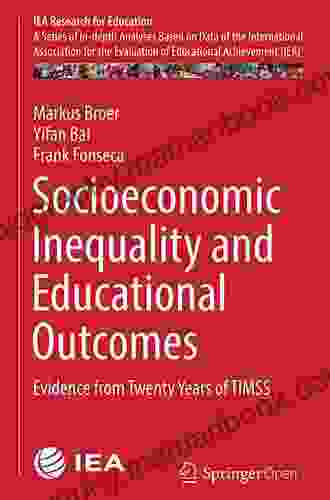Socioeconomic Inequality and Educational Outcomes: A Comprehensive Examination

Socioeconomic inequality, a pervasive issue in modern societies, has a profound impact on various aspects of human life, including educational outcomes. The interplay between social class and educational attainment is complex and multifaceted, reflecting a multitude of factors that shape individual life trajectories. This article provides a comprehensive examination of socioeconomic inequality and its consequences for educational outcomes, exploring its causes, manifestations, and potential solutions.
4.4 out of 5
| Language | : | English |
| File size | : | 5840 KB |
| Text-to-Speech | : | Enabled |
| Screen Reader | : | Supported |
| Enhanced typesetting | : | Enabled |
| Word Wise | : | Enabled |
| Print length | : | 128 pages |
Causes of Socioeconomic Inequality in Education
Socioeconomic disparities in educational outcomes are rooted in a complex interplay of factors that begin in early childhood and persist throughout the educational system. Key causes include:
Consequences of Socioeconomic Inequality in Education
The consequences of socioeconomic inequality in education are far-reaching, both for individuals and society as a whole:
Potential Solutions to Address Socioeconomic Inequality in Education
Addressing socioeconomic inequality in education requires a multi-pronged approach that involves both targeted interventions and systemic reforms:
Socioeconomic inequality has a profound impact on educational outcomes, creating a persistent challenge to educational equity. The causes and consequences of this issue are multifaceted and require comprehensive solutions that address both individual and systemic factors. By investing in early childhood education, ensuring equitable school funding, diversifying the teaching force, and promoting culturally responsive practices, we can create a more just and equitable educational system that provides all students with the opportunity to reach their full potential.
4.4 out of 5
| Language | : | English |
| File size | : | 5840 KB |
| Text-to-Speech | : | Enabled |
| Screen Reader | : | Supported |
| Enhanced typesetting | : | Enabled |
| Word Wise | : | Enabled |
| Print length | : | 128 pages |
Do you want to contribute by writing guest posts on this blog?
Please contact us and send us a resume of previous articles that you have written.
 Top Book
Top Book Novel
Novel Fiction
Fiction Nonfiction
Nonfiction Literature
Literature Paperback
Paperback Hardcover
Hardcover E-book
E-book Audiobook
Audiobook Bestseller
Bestseller Classic
Classic Mystery
Mystery Thriller
Thriller Romance
Romance Fantasy
Fantasy Science Fiction
Science Fiction Biography
Biography Memoir
Memoir Autobiography
Autobiography Poetry
Poetry Drama
Drama Historical Fiction
Historical Fiction Self-help
Self-help Young Adult
Young Adult Childrens Books
Childrens Books Graphic Novel
Graphic Novel Anthology
Anthology Series
Series Encyclopedia
Encyclopedia Reference
Reference Guidebook
Guidebook Textbook
Textbook Workbook
Workbook Journal
Journal Diary
Diary Manuscript
Manuscript Folio
Folio Pulp Fiction
Pulp Fiction Short Stories
Short Stories Fairy Tales
Fairy Tales Fables
Fables Mythology
Mythology Philosophy
Philosophy Religion
Religion Spirituality
Spirituality Essays
Essays Critique
Critique Commentary
Commentary Glossary
Glossary Bibliography
Bibliography Index
Index Table of Contents
Table of Contents Preface
Preface Introduction
Introduction Foreword
Foreword Afterword
Afterword Appendices
Appendices Annotations
Annotations Footnotes
Footnotes Epilogue
Epilogue Prologue
Prologue Kevin Tumlinson
Kevin Tumlinson Elizabeth Tammi
Elizabeth Tammi Dan Riggs
Dan Riggs Charlotte Mason
Charlotte Mason Cassy Duke
Cassy Duke Sunanda J Chatterjee
Sunanda J Chatterjee John Quincy Adams
John Quincy Adams Angela Carr
Angela Carr Timothy Brantley
Timothy Brantley Kristen Mattson
Kristen Mattson Christine Kersey
Christine Kersey Marina Bretta
Marina Bretta Justine Linden
Justine Linden Stephanie Manley
Stephanie Manley Don Rich
Don Rich Jen Brister
Jen Brister Matt Lincoln
Matt Lincoln Reginald Huff
Reginald Huff Dave Matthes
Dave Matthes Timothy Johnson
Timothy Johnson
Light bulbAdvertise smarter! Our strategic ad space ensures maximum exposure. Reserve your spot today!

 Carlos FuentesDark Sky: Joe Pickett Novel 21 by C.J. Box - An Immersive Wilderness Thriller
Carlos FuentesDark Sky: Joe Pickett Novel 21 by C.J. Box - An Immersive Wilderness Thriller
 Dwight BellNightingale Christmas Promise: Experience the Magic of Nightingales 10 This...
Dwight BellNightingale Christmas Promise: Experience the Magic of Nightingales 10 This... Stanley BellFollow ·3.5k
Stanley BellFollow ·3.5k Chance FosterFollow ·17.1k
Chance FosterFollow ·17.1k Richard SimmonsFollow ·6.1k
Richard SimmonsFollow ·6.1k Bruce SnyderFollow ·13.8k
Bruce SnyderFollow ·13.8k Earl WilliamsFollow ·10.8k
Earl WilliamsFollow ·10.8k Paulo CoelhoFollow ·2.7k
Paulo CoelhoFollow ·2.7k Devin CoxFollow ·13.1k
Devin CoxFollow ·13.1k DeShawn PowellFollow ·10.3k
DeShawn PowellFollow ·10.3k

 Barry Bryant
Barry BryantKnitting Pattern Kp190 Baby Sleeping Bags Sizes 3mths...
This easy-to-follow...

 Rudyard Kipling
Rudyard KiplingFolk Music Arrangements of Bartók: A Musical Tapestry of...
Béla Bartók, the renowned...

 Garrett Bell
Garrett BellThe Yellow House Memoir: A Literary Masterpiece that...
A Journey of Resilience,...

 George Martin
George MartinAssassin Witch Dark Faerie: The Bonegates
In the shadowy...
4.4 out of 5
| Language | : | English |
| File size | : | 5840 KB |
| Text-to-Speech | : | Enabled |
| Screen Reader | : | Supported |
| Enhanced typesetting | : | Enabled |
| Word Wise | : | Enabled |
| Print length | : | 128 pages |










